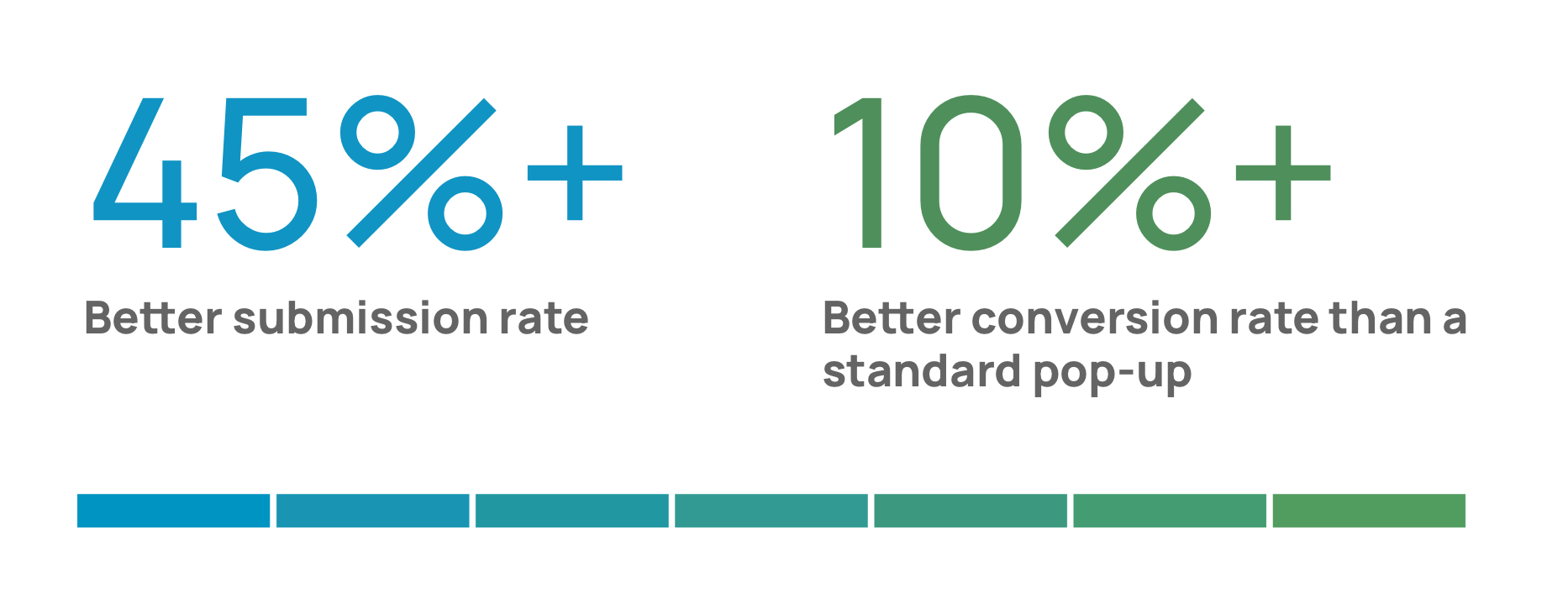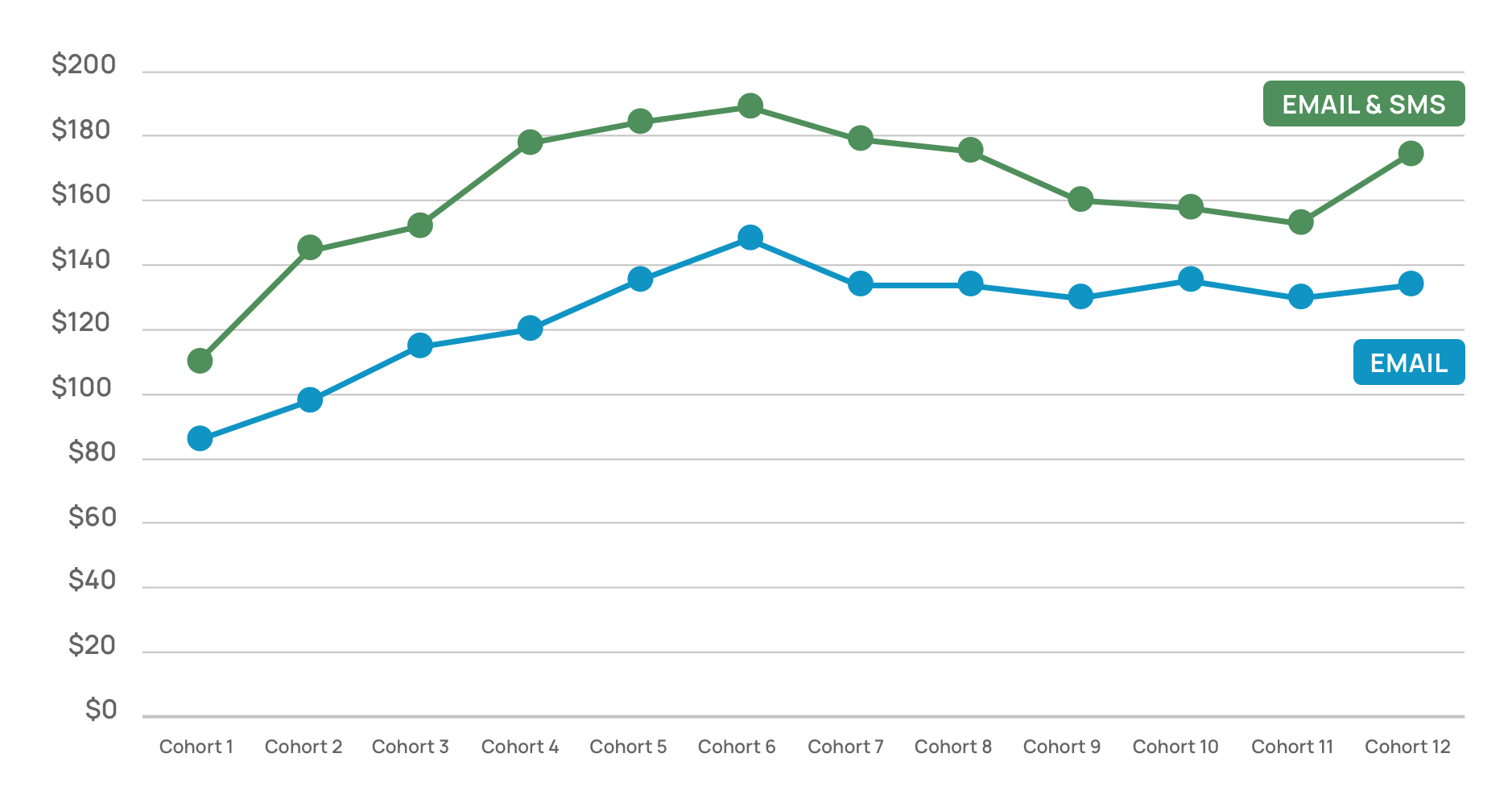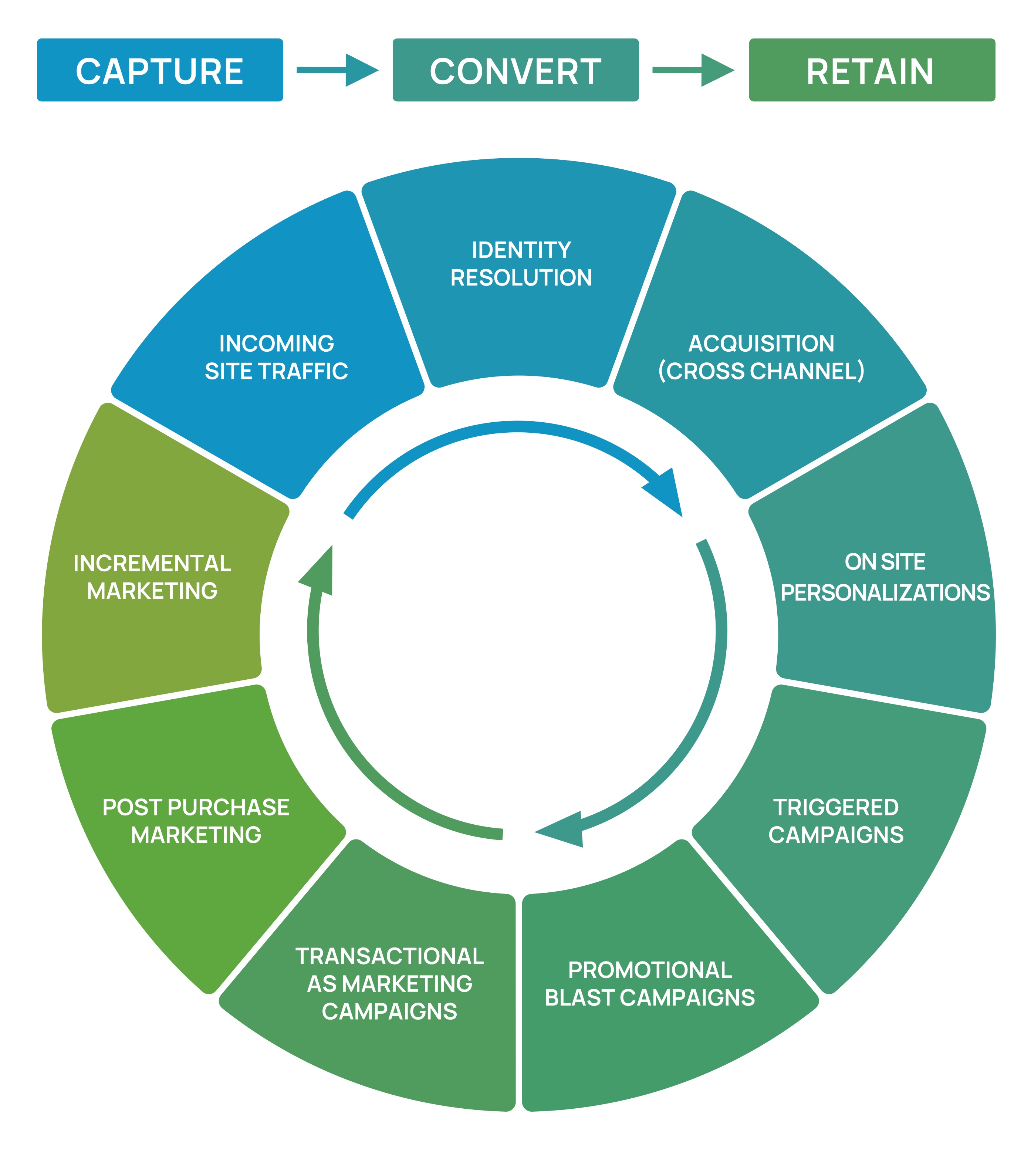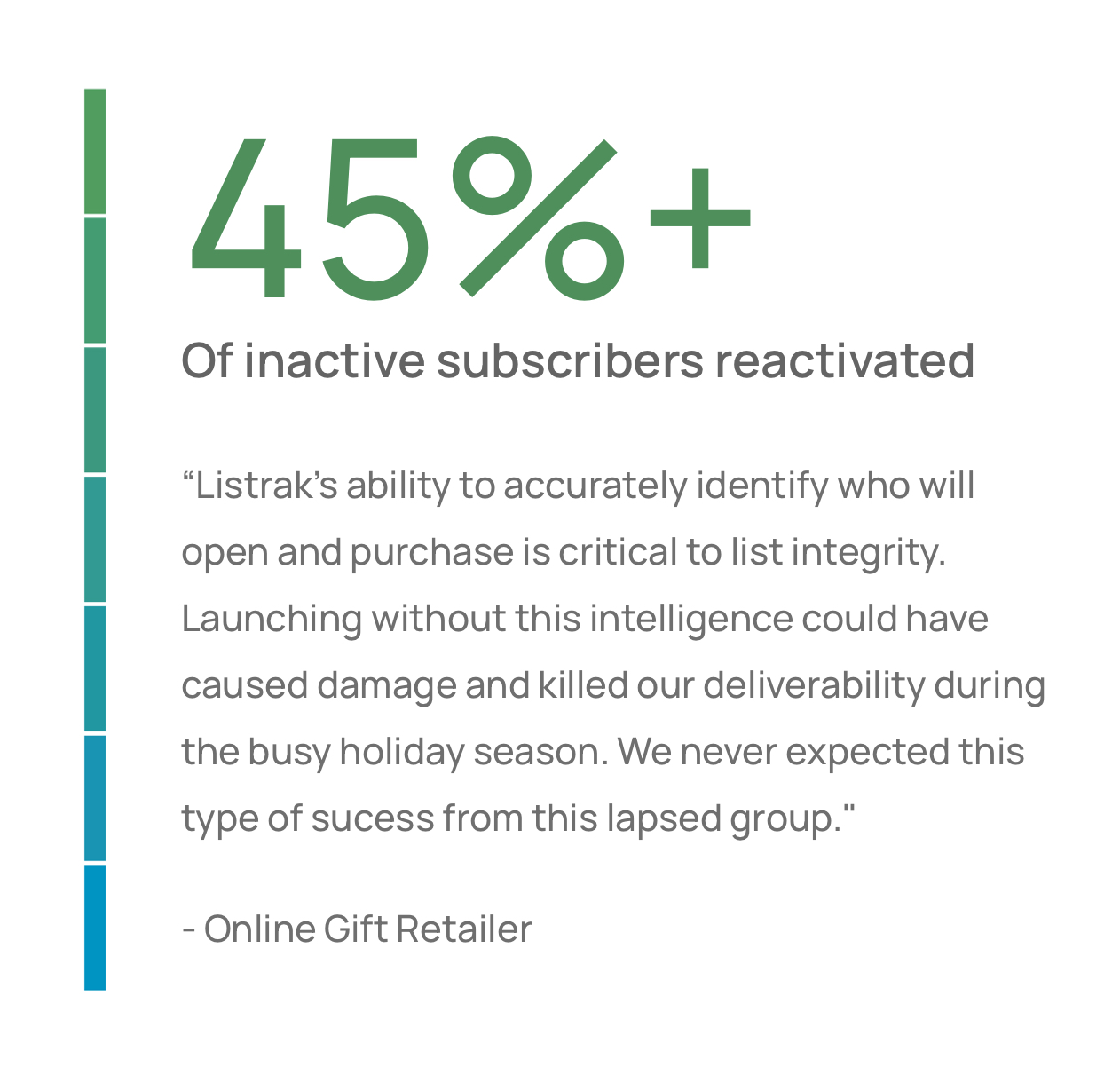5 Strategies for Next Level Retail Marketing Automation in 2022

Marketers love to see consistent growth. And for many years, retail marketing automation provided just that: consistency. Retailers had developed a proven playbook to outpace comparable year-over-year sales (“comp sales”). You knew, “If I just use these particular channels, monitor my open rates, and tack on a couple of new channels with acceptable ROAS (Return on Advertising Spend), my revenue will increase.” The growth was predictable.
For that reason, retailers had one of the highest marketing automation adoption rates of any industry. A 2021 Dun & Bradstreet survey showed that 64% of Retail CMOs had adopted marketing automation.
Benefits of Marketing Automation for Retailers
It’s easy to see why marketing automation is so attractive for retailers. In an industry that places so much focus on sales metrics like revenue, conversion rates, and customer retention, tools that boost those numbers in a cost-effective manner will always be attractive.
And the statistics prove those benefits. Marketing automation results in a 15% increase in sales productivity while decreasing marketing overhead by 12%. But just because automation tools can add effectiveness to retailers’ marketing efforts, doesn’t mean that marketers can stop adapting.
Adapting Your Retail Marketing Automation Strategy
Recently, retailers have been forced to deal with a number of previously unforeseen changes that complicate the proven retail marketing playbook. In addition to the pandemic (which was enough by itself), marketers now must deal with new privacy rules, reduced visibility, and limitations on social, just to name a few changes. In turn, retailers need to reevaluate their marketing strategies and tactics to compete in an evolving retail landscape.
Here’s the reality: retail marketing automation is table stakes now. Innovative tools and strategies that were novel just a few years ago are now industry standard. To make a real difference in your market, you can’t follow the same path that led to success previously. You need to adapt your retail marketing automation strategies to what is working today, in 2022.
In this article, we are going to explore 5 key strategies you should employ to take your retail digital marketing automation to the next level. These strategies will all be directed toward a singular goal — maximize your revenue opportunities while simultaneously optimizing your spend.
5 Strategies for Next Level Retail Marketing Automation
Strategy #1 - Recognize More Anonymous Site Visitors
To make the most of marketing automation, you need to know as much as possible about your customers. And to do that, you need data. Why is customer data so important to retailers? Well, the data helps brands analyze customer behaviors and craft personalized experiences, which increases conversions and revenue. All good things.
And one of the foundations of compiling a customer data profile is identifying the customer. But that can be a challenge with recent changes to privacy laws and the elimination of third-party cookies. It’s harder than ever to recognize site visitors, inbox message opens, and other useful metrics. On top of that, about 97% of all visitors to retailers’ websites are anonymous. Identifying these anonymous site visitors is a top priority.
The Danger in Device-Based Tracking
Identifying anonymous site visitors, of course, is a challenge in its own right — especially for retailers that rely solely on device-based tracking. If behavior is tied only to devices, there will be gaps in your data, particularly as more customers opt-out of app data sharing. On the other hand, cross-device identification and authenticated sessions can help improve identity resolution and give you more customer data to work with.
An example could help illustrate this. Suppose a potential customer visits your site on her work computer. A pop-up on your site asks for her email address, and she provides it before browsing for a little while. However, she’s soon called into a meeting and abandons. Later that evening, she visits your site again on her personal tablet, where she gets another pop-up asking for her email. She doesn’t provide it (she already gave it on her work computer), so her current shopping session isn’t tied to her email address. If she abandons again at this point, your typical ESP can’t send a cart abandonment email based on her tablet browsing—at least, not without authenticated sessions.
Authenticated Sessions and the Identity Graph
Authenticated sessions enable you to verify browsing behavior on your site and tie that behavior to individuals rather than devices. Listrak does this with identity resolution technology, using the largest commercially available identity graph. With this technology, you can determine that your prospective customer browses on a work computer, a tablet, a home laptop, and a smartphone. This information allows you to see her as the same person across all her devices rather than tracking her individual devices anonymously.
The data you gather through authenticated sessions is highly valuable since it’s all provided directly by the customer —whether that’s voluntarily by supplying you with their email address, or incidentally through their browsing behavior, visits to your site, etc. By capturing this data and creating the customer profile, you enable your marketing automation efforts to thrive.
Strategy #2 - Capture More Zero- and First-Party Data
The importance of customer data in your marketing automation strategy can’t be overstated. it can inform many of the moving parts in your marketing campaigns because it allows you to personalize your messaging and channels to the individual, which translates into improved customer experiences, engagement, and retention.
And in this retail landscape, first-party data (information collected directly from customer interactions, behaviors, or actions) and zero-party data (data intentionally shared by the customer) are at the top of retailers’ minds.
Intentionality Matters
Of course, acquiring more zero- and first-party data is no easy task. There’s a reason why marketers relied on third-party data for so many years — ease of acquisition. But new privacy regulations mean far less access to third-party data than before. As a result, it’s more important than ever to be intentional in your efforts to capture zero-party and first-party data.
This change in data acquisition will require more creativity and ingenuity on the part of marketers. You may need to try new strategies that you may never have attempted before. And there is always more you can do on top of the actions you’ve already put in place.
For example, if you already have an entry pop-up on your site, you might try adding another pop-up on exit. Another option might be to make your pop-ups more engaging, such as by including spinners or card games, or by asking for their birthday. The point is, get creative about how you’re enticing your customers to volunteer their data, and across as many channels as possible (email, SMS, browser push notifications, app push, etc.).
The results can be dramatic. For example, an interactive pop-up will typically yield a 45% better submission rate and 10% more conversions over static pop-ups. In essence, what you’re trying to do is drive more interest and ultimately increase data submission by delivering a more personalized, seamless, and unique customer experience.

Build a Relationship with Your Customers
It’s important to remember that this won’t be a set-it-and-forget-it strategy. You’ll want to continually test out different approaches in different channels to see which methods are the most effective and produce the highest returns.
Brands are always trying to build relationships with customers. But how can you make them want to build that relationship with you? You can provide them with the personalized, seamless customer experiences they expect. And zero- and first-party data helps you do that.
Strategy #3 - Truly Orchestrate Your Channels
As you implement new strategies to collect more zero- and first-party data, you’ll need to make sure that data is going to be used properly throughout all channels. That means truly orchestrating your channels to ensure they work together seamlessly — you don’t want any data to get ignored or bypassed.
What does this mean in practice? Messages must be relevant to your customers and to one another, their timeliness and cadence should be well-orchestrated, etc. The end result is to maximize your revenue while optimizing your spend.
Siloed Channels = No Orchestration
One of the major causes of orchestration failure is siloed channels. This frequently occurs if you have multiple providers managing different channels. They may battle over revenue attribution, resulting in poor communication, lost data, duplicate revenue, and a subpar experience for your customers, as they are bombarded with disparate messages at poorly timed intervals. Identity gaps, attribution duplication, lower deliverability, and orchestration failures are all common performance-limiting issues that could result from this disjointed system.
The simplest solution is to use a single provider to cover all communication channels. Doing so helps create a more cohesive retail marketing automation system with lower chances of lost data or disconnect between channels. Otherwise, there’s an increased risk that different channels won’t talk to one another, allowing data—and revenue—to fall through the cracks.
Using Preferred Channels
So what does channel orchestration look like when it’s working seamlessly? Suppose you have a customer who abandons their cart and (according to the data you’ve gathered) clearly prefers email-based marketing as their favored channel. When sending an abandonment message, an email would be the most effective way to reach them and get that conversion, meaning you may not need to bother with more costly SMS. Making sure this information is communicated between campaigns can streamline your targeted marketing processes.
On the other hand, if someone clearly engages more with texts and tends to ignore emails, SMS may be the way to go. While it may be a higher investment than email, focusing on text alone for that customer would be more cost-efficient in the long run since you’re not wasting resources on both channels.
In many cases, using both together might be most effective. In fact, on average, customers who receive both email and SMS have a 30% higher CLV (customer lifetime value) than those who receive email marketing alone.

Again, this level of personalization is difficult to coordinate if you have disparate providers handling every channel, which is why it’s often worthwhile to find a sole provider to maintain all channels you’re planning on using. In addition, this process can be further automated through predictive technology. Machine learning can assess vast swathes of data that indicate such factors as likelihood to purchase, churn, etc. and optimize your messaging accordingly to gain efficiency throughout all channels.
Strategy #4 - Capitalize on the Flywheel Effect

When thinking about marketing automation, a helpful visual to use is the marketing flywheel — which starts with capturing incoming site traffic — and moves through each stage of the customer journey. The flywheel model helps explain how the previous concepts of data acquisition and channel orchestration feed the overall success of marketing automation.
Many marketers try to optimize each individual step in the journey, but they fail to look at the process holistically. They view their marketing strategy as using one solution or channel for data capture, another for conversion campaigns, and yet another to retain customers.
Next level marketers see how marketing automation enables the individual elements of the customer lifecycle to build on each other, where the Capture stage leads seamlessly to the Convert stage, and through to the Retain stage. For example, capturing zero- and first-party data (Capture stage) enables greater personalizations (Convert stage), which fosters high engagement rates (Retain stage). However, when data gets siloed (which happens with disparate systems that don’t talk to each other), it breaks the flow of the flywheel.
These cracks in your flywheel result in lost data and ultimately lost revenue. In order to prevent these losses, you must ensure that all your channels can benefit from data gathered at every stage of the journey. This is most effective with a unified platform. To that end, consider how the following measures might feed into each other as you move around the flywheel:
Capture
Consider how zero and first-party data could be used to help you identify anonymous site visitors. That could include using authenticated sessions, cross-device identification, and channel-agnostic identity resolution methods to give you a clear picture of who is visiting your site.
Convert
Converting those visitors into customers means unifying your data through deliverability sharing and engagement/behavioral data. That data can then be used to optimize segmentation and personalize messaging for your target audience.
Retain
Finally, you’ll move on to customer retention. Think of how using data modeling with propensity scoring can maintain high engagement rates and inform sound churn prevention strategies. The end goal here is to continuously drive new traffic to supplement your current contacts.
The Flywheel in Trigger Campaigns
Let’s look at an example of the flywheel effect with a favorite of marketers — the trigger campaign.
Whether through email, text, or another channel, triggers include your abandonment messages, post-purchase campaigns, and so on. Triggered campaigns are designed to be timely and relevant while driving significant engagement with your subscribers. They always score well on deliverability.
So how can you use these highly deliverable messages to boost your overall marketing efforts? Don’t look at trigger messages as a separate entity. They are part of your overall outreach strategy. Don’t keep them separate from your broadcast and promotional messages. Leverage the high deliverability of your trigger messages to boost the overall deliverability and inbox placement of all your messages.
Why is this so important? For major retailers, tens of thousands (or even millions) of dollars are lost per percentage point lost in deliverability. If you view all your messages as independent entities rather than a part of a cohesive whole (the flywheel), you are practically guaranteed to miss significant revenue opportunities.
And triggers are only one small part of this flywheel. For brands using retail marketing automation, the possibilities to leverage one portion of your customer journey to benefit another are endless. The key is to avoid data siloes, which ultimately result in a fractured—and often frustrating—customer experience. You want cohesiveness all throughout the customer journey.
Strategy #5 - Mine for Missed Revenue Opportunities
The fifth strategy brings all of the above tactics together. Simply conducting each step once is insufficient for sustained growth. The goal is continuous improvement, and that’s why it’s vital to consistently mine for missed revenue opportunities. That means constant A/B testing and optimization while never being satisfied with the current status quo. It’s the idea that you’re never finished because there will always be some gap in your data or process that can be improved upon.
This not only means conducting your own studies into your processes, but it also means consulting with vendors and partners to mine new ideas from them as well. Your vendors should have a vested interest in improving their services since you both can stand to benefit from revenue gap analysis. The quality of the contextual content also plays an important role, a resource such as WritePaperForMe can help with this. The potential revenue that can be discovered through constant testing can add up to millions, though it does depend a great deal on the technology and services provided. Even so, you should be able to ask your provider how you can capture more revenue since there are always more optimizations to be discovered.
As you move toward more optimized retail marketing automation, the following methods could constitute ways in which you might optimize your processes:
- Dynamic content
- Predictive product recommendations
- Proper channel orchestration
- Good segmenting
- Reactivating inactive subscriber lists
These can all be highly effective ways to capture more revenue. As an example, inactive subscriber lists can be a gold mine when used with an identity graph. One retailer was able to have 24% of their inactive subscribers reactivated by using statistics to determine who would be most likely to open and purchase. Naturally, this leads to immediate revenue as well as continued growth.
Inactive subscribers reactivated resulting in immediate, substantive revenue while providing continued growth moving forward.

Of course, this is just one way to improve. If you need more ideas on different components of your business to test and optimize, look for a partner with proven retail experience.
Bonus Strategy: Ensure scalability in your automation and personalization
One final item to consider as you improve your retail marketing automation is scalability. The services you use should be able to grow with you, and there are several points to consider when evaluating that.
One item is stability. This is integral when you need to rely on service providers or specific processes to comp growth year over year. You need to know that you’re able to rely on them to be consistent and reliable. As such, issues around peak times—such as holidays—could be a red flag when considering providers. Those providers who are able to provide consistent service during peak seasons are likely to be better equipped to help you sustain continued growth.
If any issues should occur, it’s important to be able to count on your provider to resolve the issue quickly. This means efficient processes, which may be difficult if your provider relies on third-party resources, which could delay any resolution of the issue. On the other hand, a provider that owns all its own infrastructure would be less prone to these types of inefficiencies.
Adequate security protocols are a must as well, of course. Service providers who are able to scale well tend to have sound security protocols in place and are fully prepared for security audits. Compliance is crucial here since it not only makes their systems more reliable, but safeguards you against liability as well.
Finally, there’s the matter of account management. You’ll need to have consistent support, both on a day-to-day level as well as at a strategic level. Being able to deliver and implement new ideas for your retail marketing automation is a must for sustained growth.
Really, it all comes down to due diligence. Making sure your provider is able to exceed certain thresholds, provide immediate service, and deliver satisfactory throughputs, deliverability, and uptime is vital to scalability. If they use third-party resources, it will be important to know what those resources are and whether they’re likely to impede needed repairs or adjustments. The end goal is to enable you to automate more and free up more bandwidth for your own team as you grow your operations.
Building More Effective Retail Marketing Automation
The above strategies take time and resources to implement, so it’s important to be diligent and efficient as you do so. Your efforts should hit on as many strategies as possible, which is why implementing the right tools can be so valuable in driving the efficiency of your retail marketing automation.
Listrak has boosted eCommerce revenue growth for over 1000 retailers and brands, and our full-service Growth Xcelerator Platform (GXP) can help you reach your revenue goals faster.
Want to find out how it works? Schedule a demo








.png)

